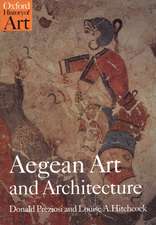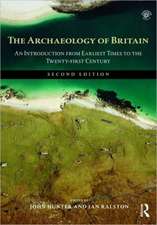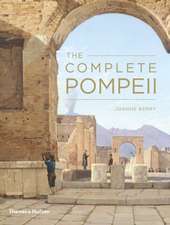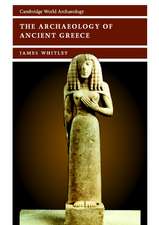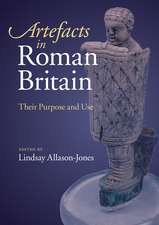Troia and the Troad: Scientific Approaches: Natural Science in Archaeology
Editat de Günther A. Wagner, Ernst Pernicka, Hans-Peter Uerpmannen Limba Engleză Hardback – 27 noi 2002
| Toate formatele și edițiile | Preț | Express |
|---|---|---|
| Paperback (1) | 1247.30 lei 38-44 zile | |
| Springer Berlin, Heidelberg – 10 apr 2011 | 1247.30 lei 38-44 zile | |
| Hardback (1) | 2101.51 lei 6-8 săpt. | |
| Springer Berlin, Heidelberg – 27 noi 2002 | 2101.51 lei 6-8 săpt. |
Din seria Natural Science in Archaeology
- 24%
 Preț: 876.52 lei
Preț: 876.52 lei -
 Preț: 441.37 lei
Preț: 441.37 lei - 20%
 Preț: 568.24 lei
Preț: 568.24 lei - 15%
 Preț: 654.30 lei
Preț: 654.30 lei - 18%
 Preț: 957.62 lei
Preț: 957.62 lei - 18%
 Preț: 1383.49 lei
Preț: 1383.49 lei - 18%
 Preț: 1233.06 lei
Preț: 1233.06 lei - 18%
 Preț: 1836.63 lei
Preț: 1836.63 lei - 18%
 Preț: 1108.99 lei
Preț: 1108.99 lei - 24%
 Preț: 685.62 lei
Preț: 685.62 lei - 18%
 Preț: 966.27 lei
Preț: 966.27 lei - 15%
 Preț: 650.86 lei
Preț: 650.86 lei - 24%
 Preț: 745.38 lei
Preț: 745.38 lei - 18%
 Preț: 1014.76 lei
Preț: 1014.76 lei - 15%
 Preț: 651.34 lei
Preț: 651.34 lei - 24%
 Preț: 821.94 lei
Preț: 821.94 lei - 18%
 Preț: 1119.71 lei
Preț: 1119.71 lei - 18%
 Preț: 787.29 lei
Preț: 787.29 lei
Preț: 2101.51 lei
Preț vechi: 2562.82 lei
-18% Nou
Puncte Express: 3152
Preț estimativ în valută:
402.16€ • 417.49$ • 335.34£
402.16€ • 417.49$ • 335.34£
Carte tipărită la comandă
Livrare economică 22 martie-05 aprilie
Preluare comenzi: 021 569.72.76
Specificații
ISBN-13: 9783540437116
ISBN-10: 3540437118
Pagini: 472
Ilustrații: XVI, 449 p. 158 illus., 3 illus. in color.
Dimensiuni: 152 x 229 x 34 mm
Greutate: 0.8 kg
Ediția:2003
Editura: Springer Berlin, Heidelberg
Colecția Springer
Seria Natural Science in Archaeology
Locul publicării:Berlin, Heidelberg, Germany
ISBN-10: 3540437118
Pagini: 472
Ilustrații: XVI, 449 p. 158 illus., 3 illus. in color.
Dimensiuni: 152 x 229 x 34 mm
Greutate: 0.8 kg
Ediția:2003
Editura: Springer Berlin, Heidelberg
Colecția Springer
Seria Natural Science in Archaeology
Locul publicării:Berlin, Heidelberg, Germany
Public țintă
ResearchCuprins
1 Introduction — Troia and Natural Sciences.- Historical and Geological Context of the Troad.- 2 The Case for Historical Significance in Homer’s Landmarks at Troia.- 3 The Relationship Between Man and Landscape in the Troad During the Ottoman Period.- 4 Heidelberg Radiocarbon Dates for Troia I to VIII and Kumtepe.- 5 Seismotectonics and Geology of Troia and Surrounding Areas, Northwest Anatolia.- 6 The Link Between the Black Sea and the Mediterranean Since the End of the Last Ice Age: Archaeology and Geology.- 7 On the Oscillations of the Black Sea Level in the Holocene Period from an Archaeological Viewpoint.- 8 The Black Sea, the Sea of Marmara and Bronze Age Archaeology — an Archaeological Predicament.- 9 Delta Evolution and Culture — Aspects of Geoarchaeological Research in Miletos and Priene.- Mineral Deposits and Materials.- 10 Early Bronze Age Metallurgy in the Northeast Aegean.- 11 On the Composition and Provenance of Metal Finds from Besiktepe (Troia).- 12 Provenance of White Marble Building Stones in the Monuments of Ancient Troia.- 13 Provenance Studies of Pottery and Granite Columns in Troia.- 14 On the Origin of Coarse Wares of Troia VII.- Archaeobiology.- 15 Environmental Aspects of Economic Changes in Troia.- 16 Troia and Fallow Deer.- 17 Troian Bird Remains — Environment and Hunting.- 18 Proposal of an Effective Concept for the Troad — a Strategy for the Preservation of an Important Ecological Building Block in the International System of Bird Migration.- 19 Rural Plenty: the Result of Hard Work — Rich Middle Bronze Age Plant Remains from Agios Mamas, Chalkidike.- 20 Regional Palaeodemographic Aspects of Troia and Its Ecosystem.- Landscape Change of the Trojan Site and Plain.- 21 Some Open Questions About the Plain of Troia.- 22 TheGeophysical Mapping of the Lower City of Troia/Ilion.- 23 Stratigraphy, Geochemistry and Geochronometry of Sedimentary Archives Around Hisarhk Hill — a Pilot Study.- 24 Sedimentary Facies Patterns and the Interpretation of Paleogeographies of Ancient Troia.- 25 Geoarchaeological Interpretations of the “Troian Bay”.- References.
Recenzii
From the reviews:
"The current volume comprises 25 archaeological science papers resulting from Korfmann’s programme of fieldwork, originally presented at a conference … . both the editors and publishers are to be congratulated on the rapidity with which this volume has appeared. … As expected from a Springer publication, the volume is attractively presented and makes excellent use of colour illustrations. … it will be a useful addition to libraries of institutions which have an interest in the east Mediterranean Bronze Age … ." (Keith Wilkinson, The Holocene, Vol. 14 (5), 2004)
"The current volume comprises 25 archaeological science papers resulting from Korfmann’s programme of fieldwork, originally presented at a conference … . both the editors and publishers are to be congratulated on the rapidity with which this volume has appeared. … As expected from a Springer publication, the volume is attractively presented and makes excellent use of colour illustrations. … it will be a useful addition to libraries of institutions which have an interest in the east Mediterranean Bronze Age … ." (Keith Wilkinson, The Holocene, Vol. 14 (5), 2004)
Textul de pe ultima copertă
When reconstructing the past, the archaeologist needs to take into account all kinds of relevant information. Where no written sources are available, the natural sciences play an indispensable role. Troia is a remarkable site in this respect. The present excavation project at Troia, under the directorship of Manfred Korfmann, integrates various disciplines including geoarchaeology, archaeobotany, zooarchaeology, anthropology, geophysical prospection as well as chemical and technological studies of metal, stone and pottery. Hardly any other archaeological project is supported so intensely and on such a broad scale by archaeometric investigations as the international research group in Troia. In April 2001 an International Symposium was held in Heidelberg, Germany, with the aim of promoting scientific discussion and providing synopses of the various disciplines engaged in Troia. This volume contains most of the contributions presented at the symposium. Due to its broad natural scientific as well as its cultural-historic scope, not only will the specialist but also the interested layman find the book rewarding.
Caracteristici
Unique combination of various scientific approaches New Insights into the size, social and economic development and other aspects of ancient Troia through scientific investigations Includes supplementary material: sn.pub/extras

